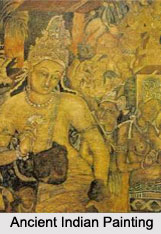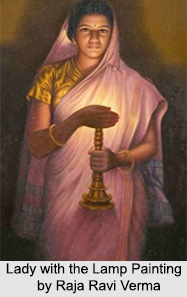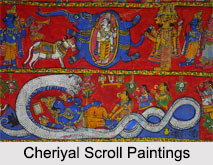 Anasara Paintings actually belong to the temple rituals in the Jagannatha Temple at Puri in the state of Orissa. During the month of June, the painted wooden deities of Subhadra, Balabhadra and Jagannatha are given ritual baths. Due to this the paint on the sculptures fades and the deities are suffering from fever. The deities are then laid to rest inside the temple for a period of fifteen days before appearing in public again. This very period is treated as a period of anasara or anavasara, which means seclusion.
Anasara Paintings actually belong to the temple rituals in the Jagannatha Temple at Puri in the state of Orissa. During the month of June, the painted wooden deities of Subhadra, Balabhadra and Jagannatha are given ritual baths. Due to this the paint on the sculptures fades and the deities are suffering from fever. The deities are then laid to rest inside the temple for a period of fifteen days before appearing in public again. This very period is treated as a period of anasara or anavasara, which means seclusion.
As the wooden deities are kept away from public, so the need arises for substitutes. Three pata paintings actually provide the substitutes which are called anasura patis, which actually form the main part of temple customs and the cult of Jagannatha. Interestingly enough, these do not at all reflect the iconic forms of the deities. Rather they represent the classical aspect of the trinity. Balabhadra is represented as Sankarsana, Subhadra as Bhubanesvari and Jagannatha as Narayana, all sitting in padmasana (lotus pose) and holding the characteristic ayudhas.
In Puri various chitrakara families paint various patis. They are specific and belong to a bada. The Chitrakara of Jagannatha Pati belongs to Jagannatha bada. This is the only occasion when paintings of chitrakaras are put inside the Lord Jagannatha temple for rituals; otherwise chitrakaras are not allowed to touch deities. This privilege is only held by Daitapatis, the descendents of Savaras, to attend to the deities during anasara.
The anasara patis are actually in the shape of scrolls with bamboo sticks tied to both ends. After the completion of the paintings by chitrakara at his house, it is hung on the wall and offered incense by the members of the family. The priest of the Puri Jagannatha, accompanied by chhatri, piper and conch blowers, come to the house of the chitrakara to collect the patis. After the completion of puja the chitrakara rolls the patis under his arms and follows the priest in procession to the temple. The pati is then unfolded and hung on a bamboo partition inside the sanctum of the temple.
The paintings are done on patis which are prepared by pasting layers of cloth with tamarind glue. The chitrakara uses conch white, hingula (cinnabar), lamp black, and haritala (orpiment) along with green and ultramarine blue. He applies smooth colours and finishes the paintings with fine lines. Although in the tradition of Orissan painting, the accent is on profile, he paints all the three figures in the frontal way, conforming to the classical sculptural tradition. The figures are antiquated.



















